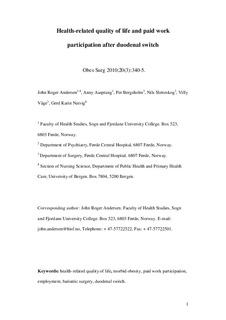Health-related quality of life and paid work participation after duodenal switch
Andersen, John Roger; Aasprang, Anny; Bergsholm, Per; Sletteskog, Nils; Våge, Villy; Natvig, Gerd Karin
Peer reviewed, Journal article
Permanent lenke
http://hdl.handle.net/11250/149345Utgivelsesdato
2010Metadata
Vis full innførselSamlinger
Originalversjon
Andersen, J. R., Aasprang, A., Bergsholm, P., Sletteskog, N., Våge, V., & Karin Natvig, G. (2010). Health-related quality of life and paid work participation after duodenal switch. Obesity Surgery, 20(3), 340-345 http://dx.doi.org/10.1007/s11695-009-9837-3Sammendrag
Background
Morbid obesity can reduce the health-related quality of life (HRQL) and paid work participation, and the duodenal switch (DS) can induce large weight loss in patients suffering from this disease. However, data about HRQL combined with paid work participation after duodenal switch are lacking. The aim of this study was to provide longitudinal data of these issues.
Methods
Fifty-one consecutive morbidly obese patients accepted for DS gave their informed consent to participate in the study. Mean age was 37.7 years (SD, 8.0), and 54.9% were women. HRQL was assessed using the “Short-Form 36 Health Status Survey”. Eight subscores, the physical component summary (PCS), and the mental component summary (MCS) were calculated. Paid-work participation was assessed as performing or not performing paid work. Data were assessed before DS (T0), 1 year after DS (T1), and 2 years after DS (T2).
Results
All the SF-36 scores improved significantly from T0 to T1 and T2 (p < 0.001), when they were in the normal range compared to the population norm. The number of patients performing paid work increased from 28 (54.9%) at T0 to 34 (66.7%) at T2, p = 0.031. The patients who performed paid work had significantly better PCS and MCS scores than those who did not before, but not after, DS.
Conclusion
Our data indicate that the SF-36 scores of the patients were normalized after DS. A marked improvement in the paid work participation was also observed.
Beskrivelse
Dette er en post-print forfatterversjon. For forlagsversjon, se Obesity Surgery, tilgjengelig online at http://www.springerlink.com/content/24357272k01k3858/
